Traditional Cornish hedge laying is a 6,000-year-old craft creating distinctive stone-faced earth boundaries that can last centuries. You’ll find these structures built with large granite foundation stones and packed soil, typically topped with vegetation. Unlike typical hedges, these are actually stone-faced earth banks requiring specialized skills to construct. Skilled hedgers can complete about one meter daily, working primarily in winter months. The ancient technique supports diverse wildlife while preserving Cornwall’s unique landscape character.
What Is Traditional Cornish Hedge Laying?
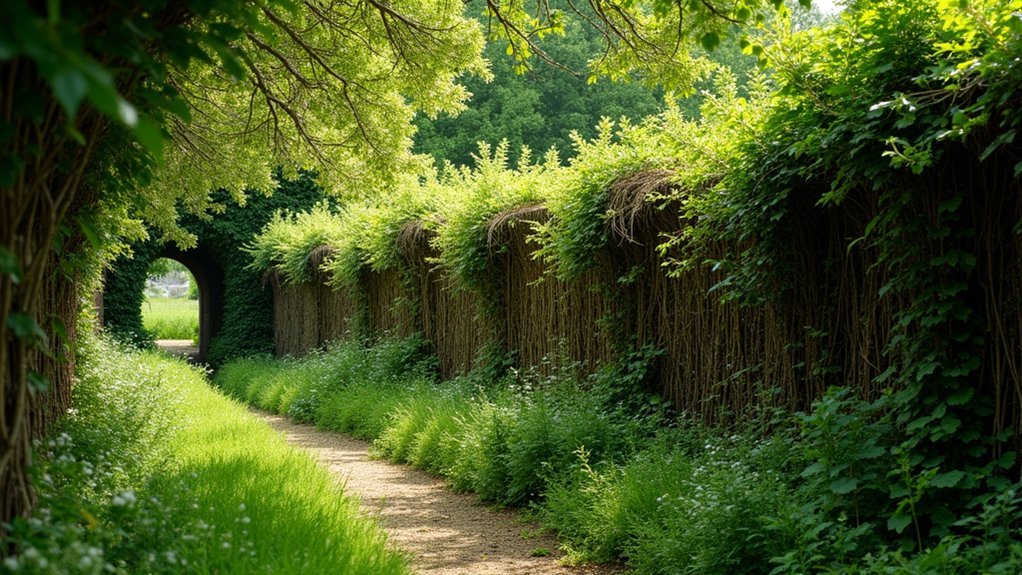
Craftsmanship defines traditional Cornish hedge laying, an ancient technique that creates stone-faced earth hedgebanks unique to Cornwall’s landscape.
You’ll find these structures built with a wide base for stability, using large granite stones and packed soil to form durable boundaries that can stand for over a hundred years.
Unlike dry stone walls, Cornish hedges feature an earth core with carefully arranged rocks, including square “edgers” that create the distinctive finished appearance.
These stone boundaries typically reach heights of 5 feet and require significant skill—expert craftspeople manage only about one meter of double-sided hedge per day.
Cornwall boasts approximately 30,000 miles of these hedges, which need restoration approximately every 150 years.
They’re crucial ecological features too, providing essential habitats for diverse wildlife.
The Origins and History of Cornish Hedges
You’ll find Cornish hedges have ancient roots dating back to the Neolithic Age, when they first enclosed agricultural land as many as 6,000 years ago.
Their presence expanded during Bronze and Iron Ages, with many examples still visible today among the 30,000 miles of hedges crisscrossing Cornwall’s landscape.
Medieval field rationalizations further shaped their patterns, with continuous construction through the 18th and 19th centuries reflecting Cornwall’s agricultural and industrial evolution.
Ancient Neolithic Beginnings
Nearly 6000 years ago, the story of Cornish hedges began when Neolithic farmers first shaped Cornwall’s landscape by constructing stone boundaries to protect their cereal crops.
These ancient structures represent some of Britain’s oldest human-made features still in use today. You can find approximately 30,000 miles of these distinctive hedges throughout Cornwall, many tracing their origins to the Bronze and Iron Ages.
When you walk alongside these weathered stone formations, you’re experiencing living history that predates many famous monuments.
Through medieval times and into the industrial revolution, locals continued building and maintaining these boundaries, adapting techniques while preserving tradition.
Today’s planning authorities recognize their significance by requiring new developments to incorporate Cornish hedges, ensuring this Neolithic innovation continues to define Cornwall’s character.
Bronze Age Construction
The foundations of modern Cornish hedge techniques emerged during the Bronze Age, when ancient craftsmen refined their skills around 2000 BCE. These remarkable structures were built using large stone blocks, establishing the distinctive stone wall foundation that defines Cornish hedges to this day.
What you’ll find fascinating is that some of these Bronze Age hedges still exist in Cornwall’s landscape, with examples dating back over 4,000 years. They represent one of Britain’s oldest continuously maintained agricultural features.
Originally created to enclose land for cereal crops, these hedges evolved from their Neolithic predecessors through improved construction methods.
The Bronze Age innovations laid groundwork for subsequent expansions during Medieval times and the industrial revolution, contributing to the impressive 30,000 miles of Cornish hedges that characterize Cornwall today.
Medieval Field Patterns
During medieval times, Cornish hedges underwent significant transformation as agricultural practices evolved across the landscape.
You’ll find that this period marked a substantial expansion in traditional Cornish hedge laying techniques as landowners rationalized their field systems for improved productivity.
While these boundary structures had already existed for thousands of years—dating back to Neolithic times when they first enclosed cereal crops—medieval farmers refined and extended the network considerably.
Field boundaries established during this period contributed to the impressive 30,000 miles of hedges that now crisscross Cornwall’s terrain.
The enduring quality of medieval Cornish hedges speaks to the craftsmanship of their builders.
Today, their historical significance is so valued that local planning authorities often require new developments to incorporate traditional hedge boundaries, preserving this living link to Cornwall’s agricultural heritage.
Essential Materials and Tools for Cornish Hedge Construction
Proper construction of a traditional Cornish hedge demands specific materials that have remained largely unchanged for centuries.
You’ll need large stone blocks, preferably granite, which form the facing of the earth bank and provide essential stability. These substantial pieces are complemented by smaller interlocking rocks that build height and structure.
Sub-soil is vital for packing the interior, supporting both the structural integrity and the vegetation that will eventually grow on your hedge.
For the finishing touch, you’ll require strips of grass to place on top, often secured with sticks for a natural appearance.
Given that professional hedgers can only complete about one metre of double-sided hedge daily, you’ll also need patience and time—perhaps the most important materials of all.
Step-by-Step Process of Building a Traditional Cornish Hedge

Begin your Cornish hedge by carefully placing large foundation stones at the base, creating a wider bottom structure that guarantees stability.
You’ll need to pack sub-soil firmly into the interior as you build upward, which distinguishes these hedges from typical dry stone walls filled with rubble.
This soil core provides essential support for the interlocking stones and creates a growing medium for the vegetation that will eventually characterize your completed hedge.
Foundation Stone Placement
When establishing a traditional Cornish hedge, the foundation stones serve as the vital anchor for the entire structure.
You’ll need to begin by digging a trench wide enough to accommodate the substantial base stones that form the hedge’s foundation.
Select your largest stones for this essential foundation stone placement. These massive rocks should be positioned tightly at the bottom of the trench, leaving minimal gaps between them.
This tight packing creates stability that will support the entire hedge.
As you work, pack sub-soil between the foundation stones to enhance structural integrity.
This foundation stone placement technique has been perfected over centuries in Cornwall, providing the necessary strength to withstand harsh weather conditions and prevent collapse.
A properly laid foundation guarantees your Cornish hedge will stand for generations.
Securing Soil Core
With your foundation stones firmly in place, the next phase involves creating a stable soil core for your Cornish hedge. You’ll need to fill the interior space between your facing stones with sub-soil, methodically compacting it as you go.
This packed earth forms the essential structural heart of your hedge, providing the stability your hedge needs to withstand weather and time.
Work in layers, ensuring each section is thoroughly compressed before adding more soil. The compaction process eliminates air pockets that could lead to future settlement and structural weakness.
Take your time with this step—proper soil packing now prevents future maintenance issues.
Remember that this core provides the foundation upon which your smaller stones and edgers will rest, ultimately supporting the living top layer of your Cornish hedge.
Structural Elements That Define Authentic Cornish Hedges
Unlike ordinary stone walls, authentic Cornish hedges feature several distinct structural elements that have stood the test of time for centuries.
You’ll notice their characteristic wide base, which provides exceptional stability and prevents stones from falling over time. This foundational design allows these remarkable structures to last well over a hundred years.
The construction begins with large stone blocks carefully packed with sub-soil, creating a solid core. Smaller interlocking rocks are then layered to build height, culminating in precise rows of square “edger” stones that give the hedge its distinctive appearance.
Building Cornish hedges requires precise layering—from foundation blocks to interlocking rocks and distinctive square edgers that define their timeless character.
The finished structure is topped with sliced grass, often secured with sticks, helping it blend naturally into Cornwall’s landscape. This meticulous craftsmanship explains why a skilled hedger completes just one meter of double-sided hedge daily.
Seasonal Considerations and Timing for Hedge Laying
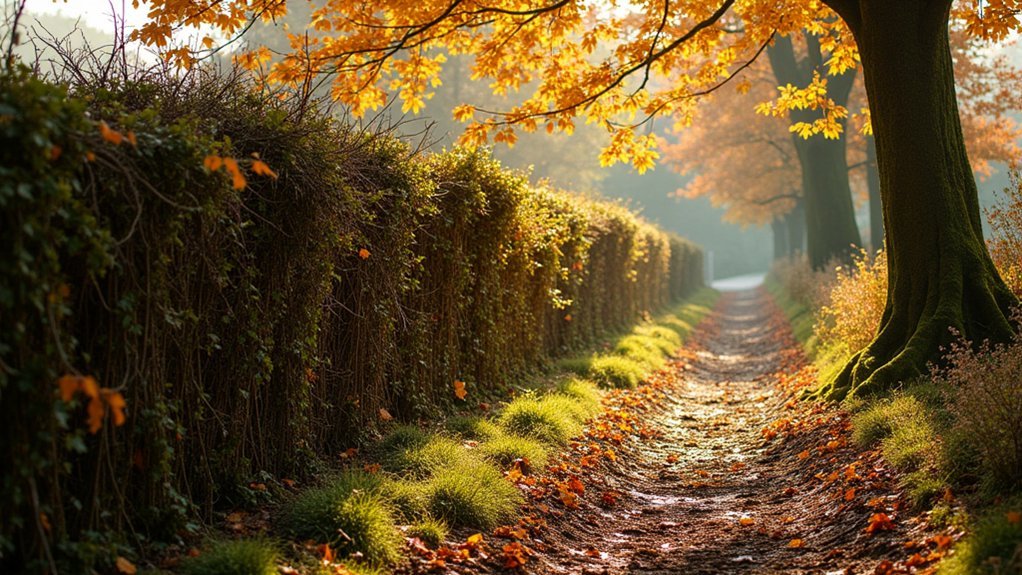
Successful Cornish hedge laying depends heavily on choosing the right time of year for both construction and maintenance. For best results, undertake traditional laying during late autumn or winter when trees are dormant, minimizing wildlife disruption and plant damage.
If you’re establishing new hedges, plan your work between November and March. This timing allows roots to properly settle before spring growth begins.
The seasonal considerations extend to weather conditions as well—avoid wet days that cause soil compaction and structural damage, instead targeting dry, cool periods for your hedge work.
Maintenance tasks like pruning and repairs are best performed in late winter or early spring when reduced foliage improves visibility of the hedge structure.
Remember that dry spells can hinder new plantings, so choose moist, mild days when possible.
Wildlife Benefits and Ecological Importance of Cornish Hedges
Ancient Cornish hedges serve as essential ecological powerhouses far beyond their role as field boundaries.
You’ll find these stone-faced banks host an extraordinary array of wildlife benefits, creating microclimates that support thousands of insect species crucial for pollination and ecosystem health.
These unique structures function as natural corridors, allowing wildlife to move safely between fragmented habitats while enhancing biodiversity across the landscape.
Cornish hedges connect isolated wildlife havens, creating vital pathways for species movement through divided landscapes.
The dense vegetation harbors both heath and woodland plant species, attracting diverse fauna that might otherwise struggle to thrive in modern agricultural settings.
Beyond supporting wildlife, Cornish hedges protect against soil erosion and mitigate flash flooding, maintaining soil health in surrounding areas.
Regional Variations in Cornish Hedge Laying Techniques
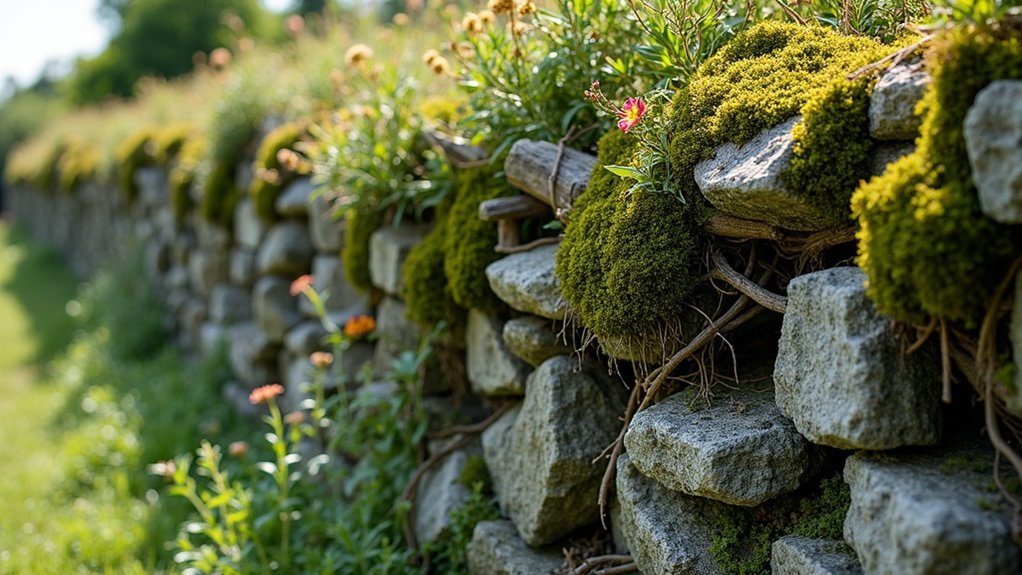
While you’ll notice distinct stones and building methods in Northern Cornwall’s hedges, where slate often replaces granite and narrower profiles accommodate the region’s landscape, the moorland variations incorporate larger foundation stones to withstand harsh weather conditions and provide shelter for grazing livestock.
Coastal Cornish hedges feature specialized construction techniques that resist salt spray and strong winds, including tighter stone packing and sometimes mortar reinforcement in particularly exposed locations.
You’ll find these regional adaptations have evolved over centuries in response to local materials, weather conditions, and agricultural needs, creating a rich tapestry of distinctive hedge-laying traditions across Cornwall.
Northern Cornish Techniques
The rugged landscape of northern Cornwall has shaped distinctive hedge laying practices that set this region apart. You’ll find these impressive structures reaching heights of up to 5 metres, with granite stones layered strategically—larger at the base for stability and packed with sub-soil to create enduring barriers.
| Feature | Northern Cornish Characteristic |
|---|---|
| Materials | Large granite stones |
| Height | Up to 5 metres |
| Construction Rate | 1 metre per day (double-sided) |
| Vegetation | Trees/shrubs on top |
| Maintenance | Regular inspection for animal damage |
When building a northern Cornish hedge, you’re participating in a labor-intensive craft where skilled practitioners construct just one metre daily. These hedges aren’t just boundaries—they’re carefully engineered ecosystems where the stone foundation supports vegetation that enhances local habitats and provides essential shelter for wildlife.
Moorland Stone Variations
Three distinct stone types characterize moorland hedge variations across Cornwall’s diverse upland regions.
You’ll notice larger granite and slate stones forming the base structure, providing essential stability against harsh moorland conditions. These hedges typically feature wider bases and variable heights, adapting to the exposed landscape.
Local craftsmen adjust their techniques based on available materials, creating regional styles unique to each moorland area. They’ll incorporate indigenous plants between stones, establishing microhabitats that support local wildlife and enhance biodiversity.
The Guild of Cornish Hedgers works diligently to preserve these moorland techniques, recognizing their importance to Cornwall’s cultural heritage.
Their efforts guarantee these traditional skills continue through generations, maintaining the authentic character of these iconic structures that have defined Cornwall’s moorland boundaries for centuries.
Coastal Construction Methods
Coastal regions of Cornwall present unique challenges for hedge builders, transforming standard techniques into specialized coastal construction methods.
When building near the sea, you’ll need to adapt traditional approaches to withstand harsh maritime conditions while maintaining structural integrity.
Three key modifications for coastal hedge construction:
- Use larger foundation stones at the base (up to 40% bigger than inland varieties) to resist coastal erosion and strong winds.
- Increase the density of packed sub-soil between stone layers to prevent salt-laden moisture penetration.
- Position flatter, more tightly interlocking edgers at the top of the hedge to minimize wind damage and reduce maintenance.
These adaptations guarantee your coastal hedge withstands Cornwall’s severe weather patterns while still providing essential wildlife habitats and maintaining the distinctive aesthetic of traditional Cornish hedgerows.
Preserving and Restoring Ancient Cornish Hedges
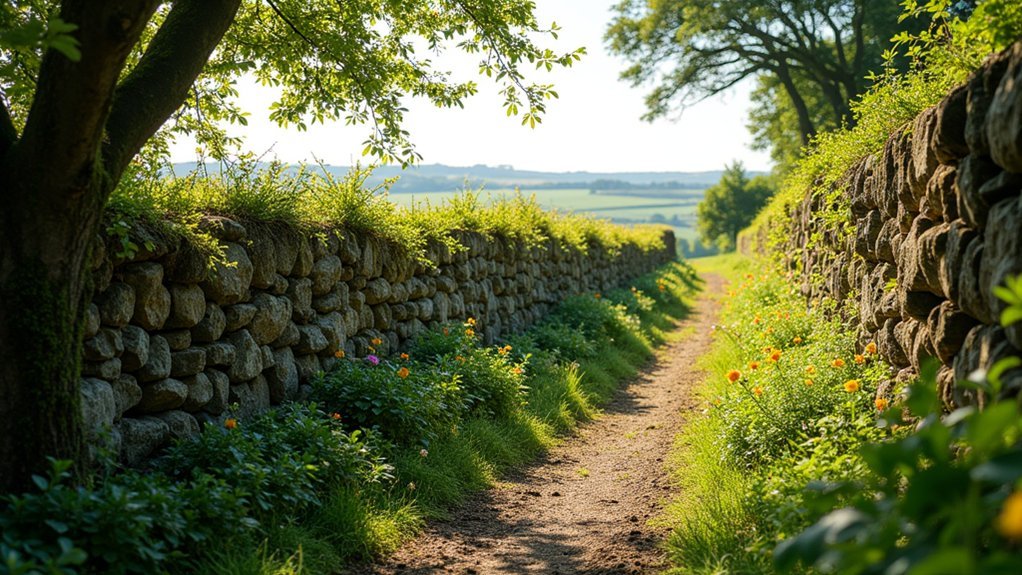
Despite their remarkable longevity, ancient Cornish hedges require substantial restoration approximately every 150 years as erosion and burrowing animals gradually weaken these historic structures.
When trees growing within hedges mature, their roots can displace stones and compromise structural integrity.
The estimated £3 million annual restoration cost proves prohibitive for many landowners, resulting in widespread neglect of these cultural landmarks.
You’ll find the Guild of Cornish Hedgers working tirelessly to address this crisis by offering apprenticeships that train new craftsmen in traditional techniques.
Conservation efforts face dual challenges: insufficient skilled workers and inadequate funding.
Regional authorities are now considering classifying hedge laying as an ancient craft, which could bolster preservation initiatives.
If you’re interested in Cornwall’s heritage, supporting these efforts helps guarantee these distinctive landscape features survive for future generations.
Challenges and Solutions in Modern Cornish Hedge Maintenance
While Cornish hedges have stood for centuries, modern conservation faces mounting obstacles that threaten these iconic structures. The £3 million annual restoration cost presents significant challenges for landowners already struggling with diminishing skilled labor pools.
Cornwall’s ancient hedges stand threatened by rising costs and vanishing expertise, creating an unsustainable burden for today’s landowners.
You’ll face three primary challenges when maintaining your Cornish hedge:
- Financial constraints – The substantial cost of professional restoration often leads to neglect, especially with the 150-year restoration cycle.
- Skills shortage – Traditional hedge-laying expertise is becoming increasingly rare, though the Guild of Cornish Hedgers is working to address this through apprenticeships.
- Ecological balance – Modern flail trimming practices can devastate biodiversity within the hedge ecosystem.
As intensive agriculture expands, finding sustainable solutions becomes critical to prevent further habitat loss and preserve Cornwall’s distinctive landscape heritage.
Frequently Asked Questions
What Does a Cornish Hedge Look Like?
A Cornish hedge looks like a stone-faced earth bank. You’ll see large stones at the bottom, smaller rocks above, with soil packed between them. It’s topped with vegetation where wildlife thrives.
What Is the Point of Hedge Laying?
You’re creating biodiversity havens, forming natural livestock barriers, preventing soil erosion, preserving traditional rural skills, and enhancing landscape beauty when you lay hedges. It’s conservation that connects you to heritage while protecting wildlife.
Why Are Hedges so High in Cornwall?
Cornish hedges reach impressive heights (up to 5 meters) to shelter livestock and crops from harsh weather. You’ll notice they’re built with broad bases and stacked stones, a technique dating back to Neolithic times.
What Is the Height of a Cornish Hedge?
Cornish hedges typically stand about 5 feet (1.5 meters) high, though you’ll find some reaching up to 16 feet (5 meters). For personal projects, you might prefer a more modest 3-foot settled height.
In Summary
You’re now equipped to appreciate and potentially practice this ancient Cornish craft. Whether you’re restoring heritage landscapes or creating new boundaries, you’ll find Cornish hedge laying connects you to centuries of tradition while supporting local ecosystems. As you’ve learned, these remarkable structures aren’t just beautiful features of Cornwall’s landscape—they’re living monuments that you can help preserve for future generations.

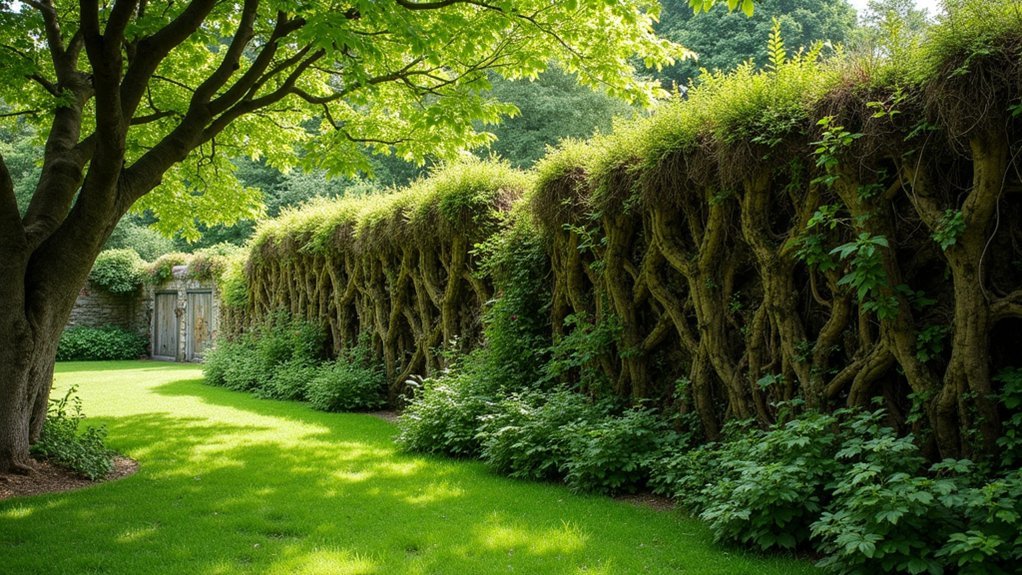



Leave a Reply